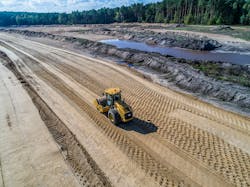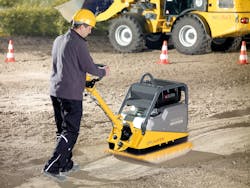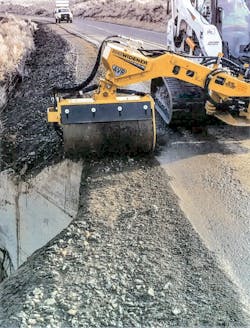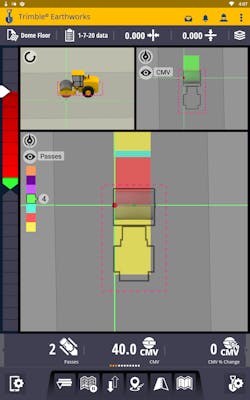“Even though the compaction of soil is a process [that] began hundreds, if not thousands, of years ago,” Luke Sevcik product application and training specialist for Wacker Neuson, guesstimates, “the compaction products and technology to achieve the best results are always improving.”
Considering that evidence of deliberate compaction of soil for street paving has been found in some of the first human settlements dating to 4000 BC in modern-day Pakistan, it’s to be expected—and hoped—that the technology has advanced somewhat.
The latest technology today is Intelligent Compaction: an improved process that incorporates rollers equipped with an integrated measurement system consisting of GPS, accelerometers, an onboard computer reporting system, and infrared thermometers.
Intelligent Compaction
In general, explains Jim Preston, intelligent paving specialist at Topcon Positioning Systems, an after-market provider of brand-agnostic systems, Intelligent Compaction monitors and maps the number and location of passes made by a roller. Called pass mapping, it’s the real-time reporting in which IC systems tell the operator how many passes have been completed to assist the operator in achieving better uniformity without over or under-compaction.
IC also measures resistance to the drum while it’s in vibratory mode, providing information about the stiffness of the substrate. Monitoring stiffness values enables operators to identify areas that have not been fully compacted. "The operator sees where he's been and what the material is doing in real-time so he can do repairs immediately,” Preston continues. By enabling the compactor to produce a more consistent surface, it also helps prevent premature failure and unexpected costs.
Trimble’s primary compaction control system is the CCS900. This onboard system uses satellite positioning technology with GPS (or UTS when obstructions like tunnels and bridges prohibit GPS) for intelligent compaction. With sensors to measure asphalt temperature and determine the optimal temperature window to achieve density, pass count, stiffness mapping, and proofing run where target densities are established, it ensures proper compaction. “You can over-compact,” confirms Devin Laubhan, paving product manager, Trimble. Too much vibration pulverizes and breaks down the aggregate, leading to flaking and crumbling. Under-compaction occurs when the air voids haven’t been removed.
The key element of IC is a measurement system on the soil compactor, states Dave Gerding, global sales consultant for soil compactors, Caterpillar. Measurement systems fall into two categories: energy-based systems and accelerometer-based systems. “In either case, it’s important to remember that the systems are not measuring the density of the soil, but are giving an indication of soil stiffness.”
With an energy-based system, like the Cat exclusive Machine Drive Power, Gerding says they are “essentially measuring the energy it takes to move the machine through the material.” When a material is relatively uncompacted, the drum sinks into it; it takes a certain amount of energy to move the machine through the material. As that same material becomes stiffer, the drum does not sink as much, and it is easier to move that same machine through the material.
The main benefit of an energy-based system is that it measures whether the drum is vibrating or not. Energy-based systems are also much more reliable in cohesive soils.
With an accelerometer-based system, called Compaction Meter Value at Caterpillar, an accelerometer is placed at or near the vibrating drum. The drum imparts a certain amount of vibratory energy onto the material. The material will vibrate in response; that vibration is picked up and measured by the accelerometer. During the first passes, when the soil is relatively uncompacted, the response vibration is much lower. As the soil becomes stiffer, the response vibration grows and indicates that the soil is reaching compaction.
The main benefit of an accelerometer-based system is the depth of measurement (39–48 inches), making it a good tool to find hidden objects (rocks, tree trunks, pockets of clay) under the soil for greenfield projects. However, the requirement for the drum to be vibrating means that you cannot get a measurement on any static passes and the technology cannot be used on machines without a vibrating drum.
IC reduces the guesswork in compaction. As Mark Eckert, product manager, compaction, for Volvo Construction Equipment explains that their IC systems feature an accelerometer-based measurement system, as well as GPS, infrared temperature sensors and an onboard computer that provides real-time compaction information to the operator. “The primary features of IC systems are pass mapping, surface temperature mapping, and data collection.”
Many IC systems display real-time pavement surface temperature information as part of temperature mapping. This is important for asphalt because the temperature impacts the material’s ability to be compacted. A skilled operator will make adjustments to the paving process to compact the asphalt at peak temperatures and avoid the need for additional passes that can drive up project costs and extend timelines.
Volvo’s Compact Assist features Density Direct to provide real-time density estimation of the percentage of air voids removed. After calibration, the system automatically plots an area for the operator to cover with four vibratory passes. When complete, Eckert says, the display shows the predicted density as a percentage.
GPS and Telematics
The measured compaction value must be connected to a location using GNSS mapping technology, Gerding explains. “Without adding a mapping system, only the operator in the machine will know the compaction value. That data isn’t stored anywhere.” By adding the GNSS mapping system, the entire compaction process is documented. In addition to compaction mapping, other parameters are also documented, such as pass count, vibration status, machine direction, and more.
Beyond geo-referencing machine position, Preston says that GPS sensors record the vibration of the drum, monitoring the amount of change in compaction between passes until an acceptable value is reached. “We work in a horizontal world. You’re not getting to an elevation: 'getting to grade.’ Rather than focusing on specific elevation measurements, we are more interested in material stiffness values.” With this solution, operators can get to the specified stiffness without waiting on test results.
Telematics allows a contractor to monitor remotely in real time and perform remote diagnostics. Because the system is continuously recording information in the background, Preston says it’s easy to run reports on machine performance. “Digital delivery of information is more prevalent today than ever, and is being driven by government agencies and owners.”
A common requirement for IC jobs by state DOTs is the use of real-time kinematic-compatible systems to increase location accuracy, Eckert indicates. Volvo’s Compact Assist and Compact Assist with Density Direct use separate GPS that can be connected to RTK base stations and cellular RTK networks to do just that.
In addition to enhancing quality control, telematics increases efficiency by reducing the need for setup personnel and surveyors onsite. But that doesn’t mean an operator is all alone. “With a telematics system, road crews are never on their own,” Eckert says. “The system can remotely access and store a range of important compactor information, including geolocation, fault codes, and service and maintenance planning. It allows contractors to know if the engine is running at too high of a temperature, for example.”
Volvo’s newest IC option, Compact Assist Start, uses the same GPS for positioning that is used for CareTrack, a lower-cost IC option that is standard on all Volvo large double-drum compactors.
Efficiencies and Productivity
The ability to accurately control the compaction process makes an operator more efficient, while reducing passes that result in over-compaction makes an operator more productive.
IC solutions help operators improve the quality of compaction in less time, Preston summarizes. Beneficial results of that include reduced fuel costs, labor, and machine maintenance.
When working with Hot Mix Asphalt, where operators are more concerned with pass counts than the percentage of area covered, Topcon’s IC systems also monitor the temperature. "Asphalt is an expensive material," Preston says. That’s why state contracts underscore the importance of ensuring it’s thoroughly rolled more than being concerned that everything is covered.
Intelligent Compaction systems help improve mat quality by providing real-time information that assists operators in producing more uniform pass coverage and reach target density results.
“Uniform density might be the single most important improvement over conventional machines and settings,” Eckert believes. Since many agencies are now adopting Percent Within Limits or Percent Within Tolerance specifications, IC-equipped compactors can increase the contractor’s incentives for most projects. He explains that the data collected by IC systems can be used for job analysis to satisfy an agency’s reporting requirements and can also be used in real-time production monitoring systems, allowing the job progression to be managed remotely.
Ensuring that operators understand how small adjustments in machine configuration and their behavior can impact performance is a game-changer for speed and accuracy. Using the newest technologies in asphalt compaction can pay for itself on the first few projects.
The benefits of Intelligent Compaction cannot be overstated, Gerding insists. “First, you are measuring everywhere the roller is compacting.” IC provides a complete view of the entire site. That is opposed to traditional in-field testing methods, where measurements are taken in a very small portion of the job site—sometimes less than 1%.
Secondly, Gerding continues, efficiency is increased by cutting unnecessary passes. “With traditional compaction and in-field measurement, contractors often have the roller operators make a set number of passes that they believe will achieve their desired compaction level. Using a measurement technology like MDP or CMV will allow the operator to watch the compaction level grow and stop compacting once they’ve reached the desired level.” He mentions examples of contractors completing compaction with up to 75% fewer passes.
Finally, he says, IC can help contractors identify problem areas during the compaction process. “There could be pockets or large areas where the mix is not homogenous, or the moisture content is not optimal. Without compaction measurement, the operator would do their set number of passes in that area, then move on. Later, [if] the in-field tests reveal that compaction levels were not met, that area must be re-compacted or re-worked until it does meet proper compaction.” IC enables immediate corrective action to reduce the impact and cost.
The Over-Under on Compaction
Optimal moisture and gradation are critical for proper soil compaction. Temperature is crucial for the proper compaction density of asphalt—if it’s too cold, it doesn’t compact properly, but if it’s too hot, it spreads. Therefore, it’s important to avoid over-compaction of soil, which can change the gradation of the coarse material by crushing the smaller sizes and reducing the weight-bearing strength. According to Sevcik, if the material is too dense, over-compaction can even lead to machine damage.
Knowing how fast you can operate to achieve the desire material density and lift depth may result in fewer passes and more uniform compaction. Making fewer passes reduces fuel usage, machine hours, and manpower costs.
Wacker Neuson's compaction monitoring system, Compatech—available on some of its larger reversible plate compactors and trench rollers—determines when the soil has reached the desired compaction result. The system provides measurements of the compaction process through a series of LED lights: the number of green lights increases with each pass until maximum compaction is achieved. It’s particularly useful for less-experienced operators but helps all operators avoid unnecessary passes.
Wacker Neuson’s larger soil compactor rollers also feature a compaction meter to optimize time and fuel when compacting granular or cohesive soil, such as gravel and clay, respectively. Sevcik says, “These rollers are offered in two configurations with either a smooth drum or pad foot, but the compaction meter works for either soil type.” The soil compaction meter reacts to both machine speed and substrate density, with color-coded LEDs to indicate speed and soil reaction to the machine’s force.
Off-Set
The inspiration for Road Widener’s Offset Vibratory Roller came from concern for operators risking their safety while compacting on slopes. Instead of using the drum as a source of motion, compaction, and stability—a configuration that makes a compactor prone to tipping on slopes—they relocated the drum to an offset arm attachment. This provides stability, making the procedure safer.
The compaction roller is a separate system that can be connected to equipment contractors already own, for increased versatility, explains Lynn Marsh, president of Road Widener, LLC. “We designed the Offset Vibratory Roller to fit onto the equipment contractors already own and use every day.” An operator can drive the host machine on flat ground while the arm extends to the furthest, steepest edge of sloping road shoulders and ditches, she elaborates.
The operator can adjust the arm from the cab of the host machine, using a remote control. "The operator can also fine-tune the drum," Marsh points out. The drum can pivot up to 30 degrees and reach up to 30 inches below the arm's mounting point so it can compact slopes at various angles.
Because the roller has no onboard engine or transmission, Marsh says there’s 90% less maintenance: no oil changes, filters, or transmission fluid. And, because Road Widener’s design doesn’t use the compaction drum to stabilize and propel the host machine, interchangeable drum sizes can be swapped out to suit different applications. Its compact size enables easy transport because it fits on most trailers that can be towed by a standard pickup truck.
Coming Soon
Trimble’s grade control software, Earthworks, is offered for soil compactors only, but Laubhan says to expect new features to be added and for it to be compatible with additional machinery, like asphalt compactors, soon.
In another development, Roadworks, Trimble's next-generation software with a new platform and operating system, is replacing their legacy products. "It's a platform refresh," Laubhan explains, listing advantages like its updated display, better graphics, and additional telematic features. It saves fuel, exerts less wear and tear on the machines, and is faster to compaction. It will also provide efficiency gains. Although Laubhan says those can be hard to quantify, it will keep up with the paver for up to 35% faster and more consistent compaction.
Compaction specs are more prevalent in today’s contracts because smoothness is important, Laubhan states. “DOTs require the use of technology on jobs; it’s part of big projects now.” That’s because, he believes, “Compaction is one of the most important aspects of the paving job.”






